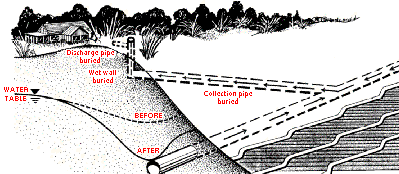| Environment and development in coastal regions and in small islands |
Coastal
management sourcebooks 1
Case 11
New ways to reduce beach erosion
E N V I R O N M E N T A L
B A C K G R O U N D
Commonly used measures to protect beaches and reduce beach erosion are usually divided into two groups: hard engineering structures (such as groynes, seawalls, revetments and offshore breakwaters); and soft engineering options like beach nourishment.
The hard engineering options have been discussed earlier, particularly in Cases 1 and 4, and Case 5 was devoted to beach nourishment. There are, however, several newer techniques now being used to protect beaches. These are the subject of this case.
Beachface dewatering promotes drainage of incoming waves.
Beachface dewatering basically consists of continuously pumping water away from the beachface. The system is based on the idea that, when the water table under the beach is lower than under the ocean, sand accretion is enhanced. As each wave rushes up the beach, water from the wave easily drains through the dry beach, leaving part of its suspended sand load on the beach. Less water drains back into the ocean taking less sand with it. (See Figure 30.)
| Figure
30. How beachface dewatering works. When the water table under the beach is lowered, water from the wave easily drains through the dry beach, leaving part of the suspended sand load on the beach. Thus, the beach accretes (adapted from Coastal Stabilization Inc., 1989). |
 |
A specially designed drainage system is installed under the beach, with pumps removing groundwater from under the beach. (See Figure 31.) When considering such systems, operation and maintenance costs must be taken into account. The pumps should run continuously.
| Figure 31. Beachface dewatering system.
Water is continuously drained from the beachface and discharged behind the dune (adapted from Coastal Stabilization Inc., 1989). |
 |
Another technique that has been tried in the Caribbean, as in other parts of the world, is artificial seaweed. In one pilot project tried in Barbados (Atherley, 1989), several hundred units of artificial seaweed were placed in the water. These units consisted of 1.3 m (4 ft) long fronds attached to an anchor tube filled with sand. (See below.) The seaweed units reduce the speed of the current, thereby allowing sand to be deposited around and on top of the seaweed units. The end result is that the seaweed units are buried by an offshore sand bar. This offshore sand deposit will then protect the beach from wave action. However, experiments in Barbados with one type of artificial seaweed showed that the particular material was not suitable for Caribbean waters, since it showed significant deterioration within eight months of installation.
The technique of coastal vanes has been tried on a local scale, for example in front of one beachfront property. Coastal vanes are small-scale, flexible structures moored to the sea-bottom that are designed to change the wave direction in front of the property. By slowing down the longshore transport rate along a particular section of beach, they are supposed to encourage sand accretion.
One technique that is sometimes mistakenly perceived to be a beach protection measure is the construction of an artificial reef. The main purpose of artificial reefs is to provide additional habitat for fish and the organisms on which they feed. These reefs are constructed of various materials, including used car tyres, old ships and car wrecks. Since they are often placed in fairly shallow depths, people sometimes suppose that they will work as offshore breakwaters. However, they rarely successfully perform this function because they are not strong enough to cause the waves to break and thus cannot provide the beach with shelter from waves. Floating tyre breakwaters are sometimes used as artificial reefs and may also be used in marinas to provide protection from boats’ wakes. (See also Case 4, Figure 20.)
| Artificial reefs are more useful for providing habitat for fish than for protecting the beach. |
P R A C T I C A L
R E S P O N S E S
Obtain as much information as possible.
These measures often seem attractive because they cost less than more commonly used measures. However, it is important to obtain as much information as possible both from the contractor/supplier and from others.
Visit locations where the techniques have worked.
Ask the supplier about locations where the technique has worked or use sources like the Internet for information. If possible, visit an installation to see for yourself and talk to the people involved at other installations.
Consult with experts in the field of coastal dynamics.
These individuals may be able to help you evaluate the technique or direct you to other sources who can.
Consult with local planning authorities.
Remember that it is always necessary to obtain permission from the planning authorities for any coastal construction and for using the seabed for any purpose. Planning authorities may also be able to provide advice.
Do not be influenced by low price-tags.
Low-cost measures often work very well, but only under specific conditions. It is up to you to find out whether your site fits those specific conditions. In most cases, ‘you get what you pay for’. The key is to put a lot of time into evaluating the low-cost alternative. However, for a particular individual in a specific context, the alternative may be worth the attempt, even if it is ultimately unsuccessful and fails. Some of the measures described here may have high operation and maintenance costs, which can outweigh the low installation costs.
Inform your neighbours.
As with any other technique, inform your neighbours and see if they are interested in joint efforts.
| Gather information and study all the alternatives before making a decision. Cost is only one factor. |